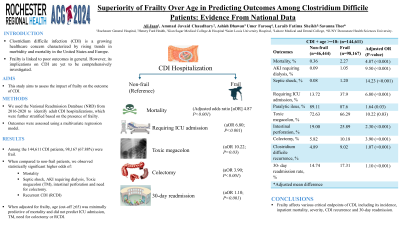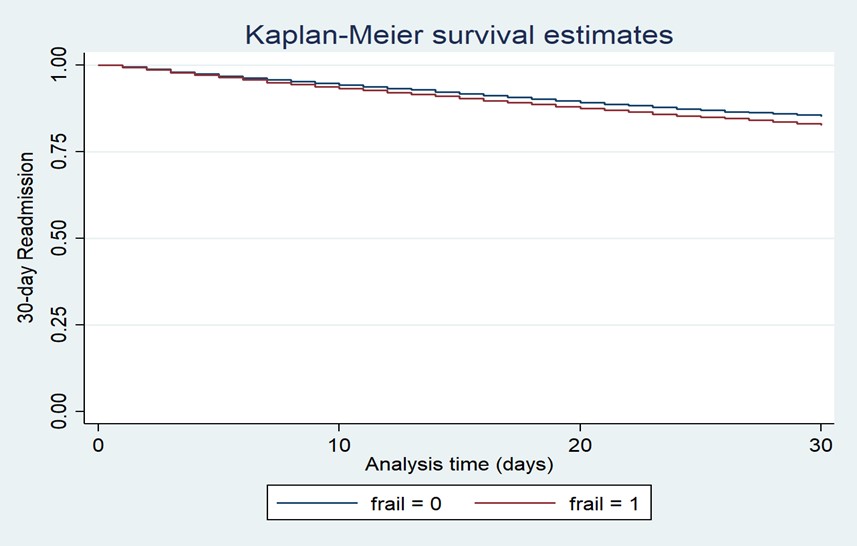Sunday Poster Session
Category: Colon
P0227 - Superiority of Frailty Over Age in Predicting Outcomes Among Clostridium Difficile Patients: Evidence From National Data
Sunday, October 27, 2024
3:30 PM - 7:00 PM ET
Location: Exhibit Hall E

Has Audio

Ali Jaan, MD
Rochester General Hospital
Rochester, NY
Presenting Author(s)
Ali Jaan, MD1, Ammad Javaid. Chaudhary, MD2, Ashish Dhawan, MBBS3, Umer Farooq, MD4, Laraib Fatima. Sheikh, 5, Savanna Thor, DO, MPH6
1Rochester General Hospital, Rochester, NY; 2Henry Ford Health, Detroit, MI; 3Gian Sagar Medical College and Hospital, Chandigarh, Chandigarh, India; 4SSM Health Saint Louis University Hospital, St. Louis, MO; 5Lahore Medical and Dental College, Rochester, NY; 6SUNY Downstate Health Sciences University, Brooklyn, NY
Introduction: Clostridium difficile infection (CDI) is a growing healthcare concern characterized by rising trends in morbidity and mortality in the United States and Europe. Consequently, there is a growing imperative to prioritize prevention and control measures. While frailty has been linked to poor outcomes in general, its implications in patients with CDI are yet to be comprehensively investigated. This study aims to bridge this gap by conducting a nationwide analysis.
Methods: Using the National Readmission Database (NRD) from 2016 to 2020, we employed the International Classification of Diseases, 10th revision, Clinical Modifications (ICD-10-CM) codes to identify adult patients (age >18 years) admitted with CDI. We further stratified CDI hospitalizations based on the presence of frailty. Utilizing a multivariate regression model, we assessed the impact of frailty on CDI outcomes. STATA 14.2 was utilized for statistical analysis.
Results: We included 144,611 adult patients with CDI, of whom 98,167 (67.88%) were frail (Table 1). After adjusting for confounding variables, in-hospital mortality due to CDI was significantly higher in frail patients (adjusted odds ratio [aOR] 4.87). Additionally, frail patients had higher odds of AKI requiring dialysis (aOR 9.50), septic shock (aOR 14.23), and intensive care unit (ICU) admission (aOR 6.80). Complications specific to CDI were also found to have elevated odds in frail patients, such as paralytic ileus (aOR 1.64), toxic megacolon (TM) (aOR 10.22), intestinal perforation (aOR 2.30), and severe disease requiring colectomy (aOR 3.90). CDI recurrence (CDR) also had higher odds in frail patients (aOR 3.65). Finally, resource utilization estimated by total parenteral nutrition requirement, total hospitalization charges, length of stay, rehabilitation discharge, and 30-day readmission rates was also higher among frail patients (Table 1, Figure 1). When adjusted for frailty, age (cut-off ≥65) was minimally predictive of mortality and did not predict ICU admission, TM, colectomy or CDR.
Discussion: Our study underscores the significant association between frailty and various critical endpoints of CDI, including its incidence, inpatient mortality, severity and CDI recurrence. Additionally, frailty emerged as an independent predictor of resource utilization. Recognizing frailty as a determinant of CDI outcomes can aid clinicians in risk stratification for this population.

Note: The table for this abstract can be viewed in the ePoster Gallery section of the ACG 2024 ePoster Site or in The American Journal of Gastroenterology's abstract supplement issue, both of which will be available starting October 27, 2024.
Disclosures:
Ali Jaan, MD1, Ammad Javaid. Chaudhary, MD2, Ashish Dhawan, MBBS3, Umer Farooq, MD4, Laraib Fatima. Sheikh, 5, Savanna Thor, DO, MPH6. P0227 - Superiority of Frailty Over Age in Predicting Outcomes Among Clostridium Difficile Patients: Evidence From National Data, ACG 2024 Annual Scientific Meeting Abstracts. Philadelphia, PA: American College of Gastroenterology.
1Rochester General Hospital, Rochester, NY; 2Henry Ford Health, Detroit, MI; 3Gian Sagar Medical College and Hospital, Chandigarh, Chandigarh, India; 4SSM Health Saint Louis University Hospital, St. Louis, MO; 5Lahore Medical and Dental College, Rochester, NY; 6SUNY Downstate Health Sciences University, Brooklyn, NY
Introduction: Clostridium difficile infection (CDI) is a growing healthcare concern characterized by rising trends in morbidity and mortality in the United States and Europe. Consequently, there is a growing imperative to prioritize prevention and control measures. While frailty has been linked to poor outcomes in general, its implications in patients with CDI are yet to be comprehensively investigated. This study aims to bridge this gap by conducting a nationwide analysis.
Methods: Using the National Readmission Database (NRD) from 2016 to 2020, we employed the International Classification of Diseases, 10th revision, Clinical Modifications (ICD-10-CM) codes to identify adult patients (age >18 years) admitted with CDI. We further stratified CDI hospitalizations based on the presence of frailty. Utilizing a multivariate regression model, we assessed the impact of frailty on CDI outcomes. STATA 14.2 was utilized for statistical analysis.
Results: We included 144,611 adult patients with CDI, of whom 98,167 (67.88%) were frail (Table 1). After adjusting for confounding variables, in-hospital mortality due to CDI was significantly higher in frail patients (adjusted odds ratio [aOR] 4.87). Additionally, frail patients had higher odds of AKI requiring dialysis (aOR 9.50), septic shock (aOR 14.23), and intensive care unit (ICU) admission (aOR 6.80). Complications specific to CDI were also found to have elevated odds in frail patients, such as paralytic ileus (aOR 1.64), toxic megacolon (TM) (aOR 10.22), intestinal perforation (aOR 2.30), and severe disease requiring colectomy (aOR 3.90). CDI recurrence (CDR) also had higher odds in frail patients (aOR 3.65). Finally, resource utilization estimated by total parenteral nutrition requirement, total hospitalization charges, length of stay, rehabilitation discharge, and 30-day readmission rates was also higher among frail patients (Table 1, Figure 1). When adjusted for frailty, age (cut-off ≥65) was minimally predictive of mortality and did not predict ICU admission, TM, colectomy or CDR.
Discussion: Our study underscores the significant association between frailty and various critical endpoints of CDI, including its incidence, inpatient mortality, severity and CDI recurrence. Additionally, frailty emerged as an independent predictor of resource utilization. Recognizing frailty as a determinant of CDI outcomes can aid clinicians in risk stratification for this population.

Figure: Figure 1: Kaplan-Meier curve for 30-day all-cause readmission among clostridium difficile hospitalizations, stratified by frailty.
Note: The table for this abstract can be viewed in the ePoster Gallery section of the ACG 2024 ePoster Site or in The American Journal of Gastroenterology's abstract supplement issue, both of which will be available starting October 27, 2024.
Disclosures:
Ali Jaan indicated no relevant financial relationships.
Ammad Chaudhary indicated no relevant financial relationships.
Ashish Dhawan indicated no relevant financial relationships.
Umer Farooq indicated no relevant financial relationships.
Laraib Sheikh indicated no relevant financial relationships.
Savanna Thor indicated no relevant financial relationships.
Ali Jaan, MD1, Ammad Javaid. Chaudhary, MD2, Ashish Dhawan, MBBS3, Umer Farooq, MD4, Laraib Fatima. Sheikh, 5, Savanna Thor, DO, MPH6. P0227 - Superiority of Frailty Over Age in Predicting Outcomes Among Clostridium Difficile Patients: Evidence From National Data, ACG 2024 Annual Scientific Meeting Abstracts. Philadelphia, PA: American College of Gastroenterology.
